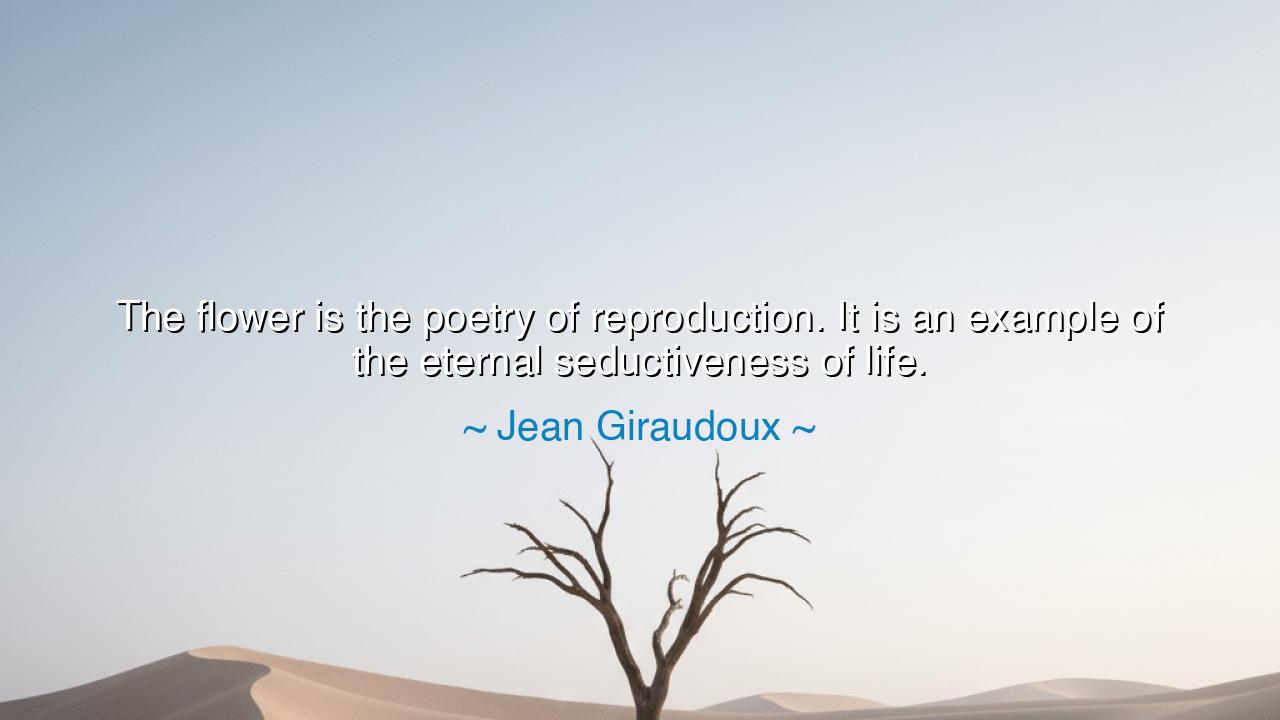
The flower is the poetry of reproduction. It is an example of the
The flower is the poetry of reproduction. It is an example of the eternal seductiveness of life.






The words of Jean Giraudoux—“The flower is the poetry of reproduction. It is an example of the eternal seductiveness of life”—carry with them the fragrance of both mystery and revelation. In them, we see the poet’s gaze upon the simplest of nature’s wonders and his discovery of a cosmic truth: that even in something as ordinary as a flower, life hides its most profound message. The bloom is not merely a biological instrument, not merely a stage in the cycle of reproduction; it is a hymn, a verse written by creation itself, to remind us of the beauty and the allure woven into existence.
The ancients understood this truth long before science gave names to the processes of pollination and fertility. To the Egyptians, the lotus was sacred, rising pure and radiant from the murky waters of the Nile, symbolizing rebirth. The Greeks adorned their myths with roses, lilies, and violets, knowing that the flower was more than ornament—it was a vessel of divine desire, a sign that life perpetually beckons us toward continuation and renewal. Thus, Giraudoux’s words echo an ancient chorus: the bloom is both symbol and substance of life’s eternal longing to endure.
The poetry lies in the paradox: the flower is fragile, delicate, and fleeting, yet its purpose is among the most enduring of all—the continuation of the species. Its beauty seduces bees, birds, and even human beings, not merely for admiration, but for participation in the great rhythm of existence. In this way, the flower mirrors human love and attraction: what appears as romance and desire is, beneath the surface, the deep call of life to perpetuate itself, to overcome death with renewal. Seductiveness is not a flaw of life—it is life’s eternal strength, the golden thread that binds one generation to the next.
History, too, gives us illustrations of this truth. Consider the hanami of Japan, the spring festival in which people gather to view the cherry blossoms. The blossoms, brief and breathtaking, are cherished precisely because they fade so quickly, reminding all who see them of both the beauty and the brevity of life. Yet beneath this fragile spectacle lies a deeper truth: those blossoms are not only poetry for the eye, but instruments of continuation, heralds of seeds, and promises of fruit. In this way, the people are not only admiring beauty, but unconsciously paying homage to the seductiveness of life itself.
The deeper meaning of Giraudoux’s words lies in their recognition that existence does not persist through duty alone, but through allure, wonder, and enchantment. If life were only toil and survival, it would wither. But life surrounds its most vital processes with beauty—with blossoms, with songs, with longing—so that creation itself becomes irresistible. Thus, the flower is not accidental poetry; it is the very strategy of life, ensuring that even the most serious work of reproduction is clothed in radiance.
The lesson for us is profound: seek beauty not as something separate from necessity, but as part of the very structure of existence. Recognize that in your own life, what draws you with love, with wonder, with longing, is not frivolous but essential. Just as the flower makes reproduction into art, so too can we make our lives into something both useful and beautiful. To embrace beauty is not to escape responsibility—it is to fulfill it with joy.
Therefore, let us walk the earth as Giraudoux instructs, seeing in every flower the eternal sermon of life. Let us honor the poetry in creation, knowing that beauty and necessity are not opposed, but joined as one. Let us learn from the seductiveness of life, which whispers to us not merely to endure, but to create, to love, to continue. For in the end, the flower teaches us that life is not only survival—it is art, and to live fully is to participate in the eternal poem of existence.






AAdministratorAdministrator
Welcome, honored guests. Please leave a comment, we will respond soon